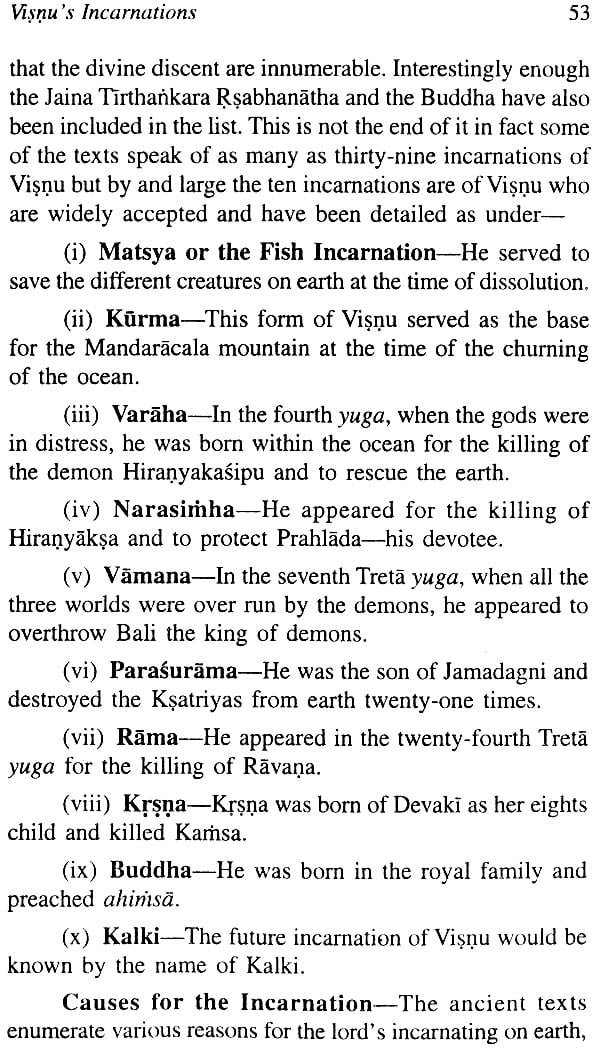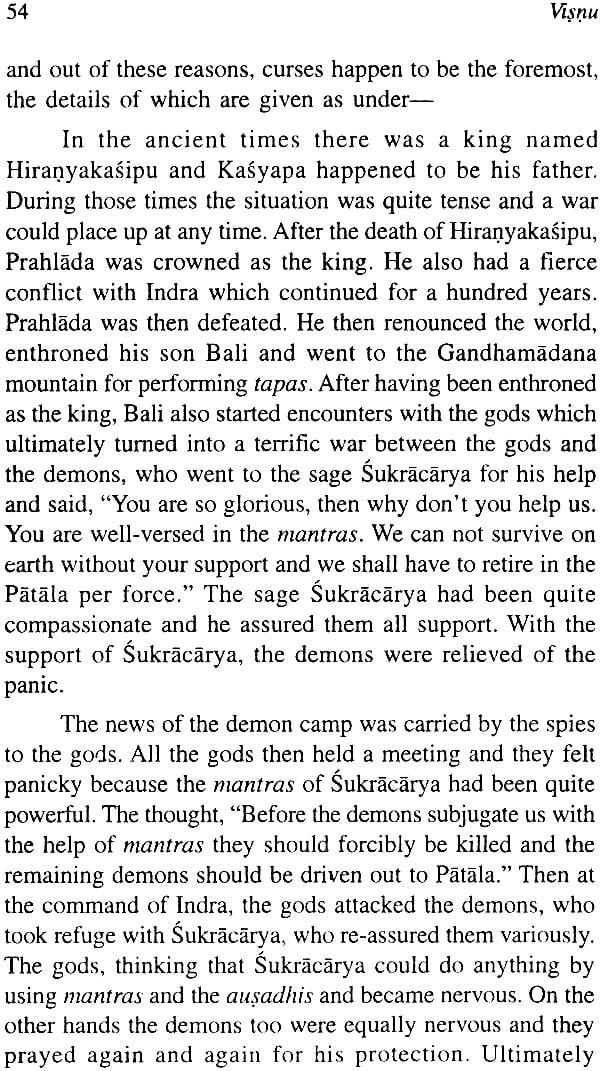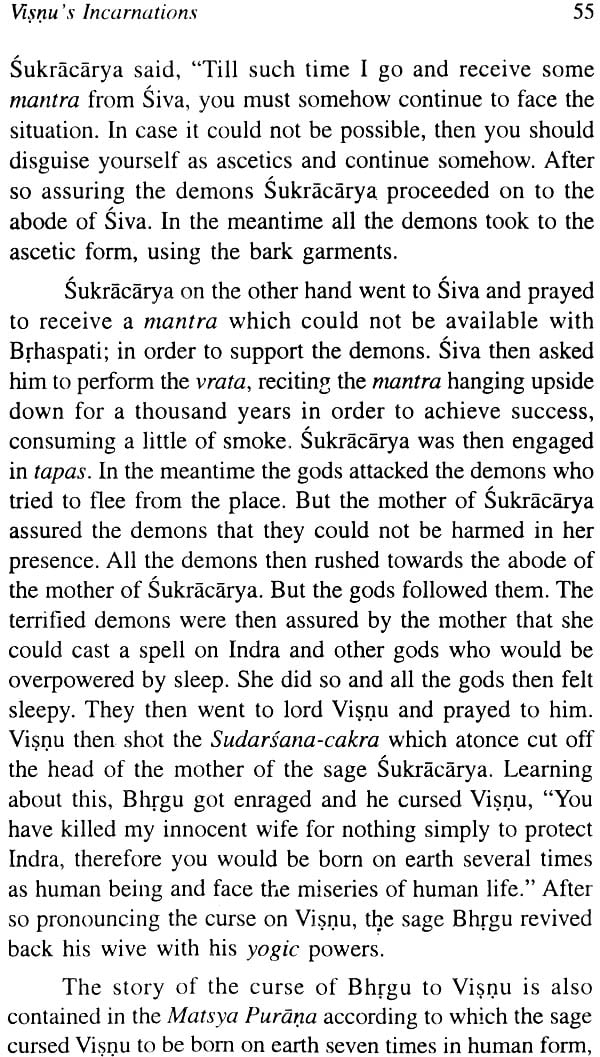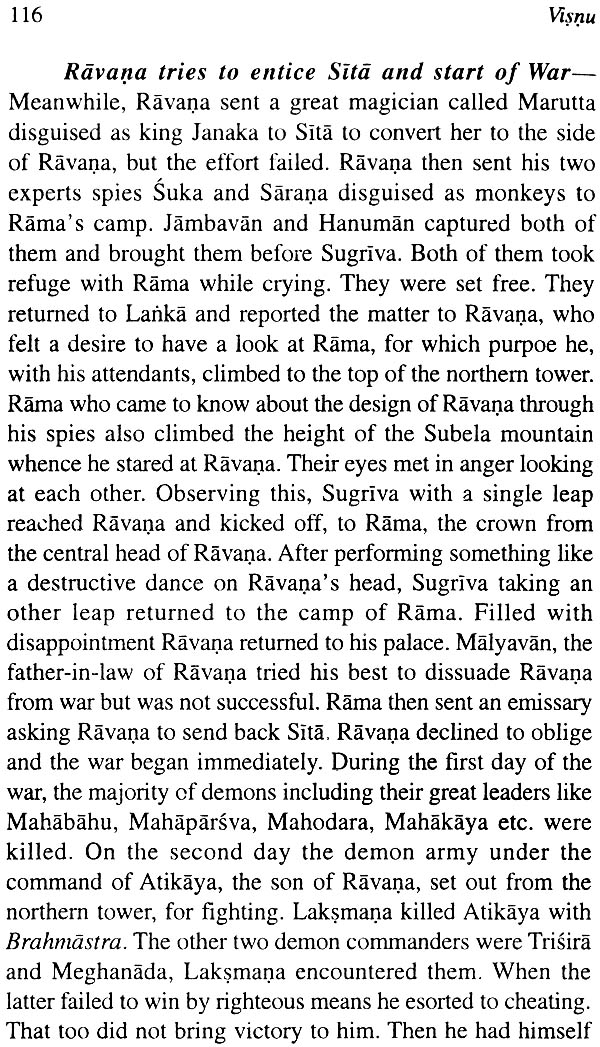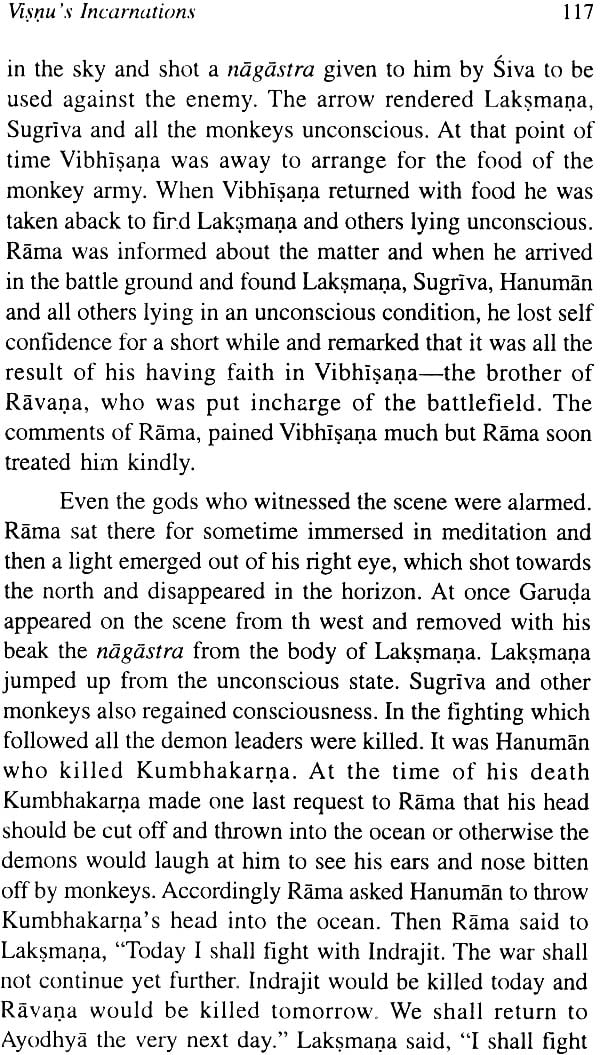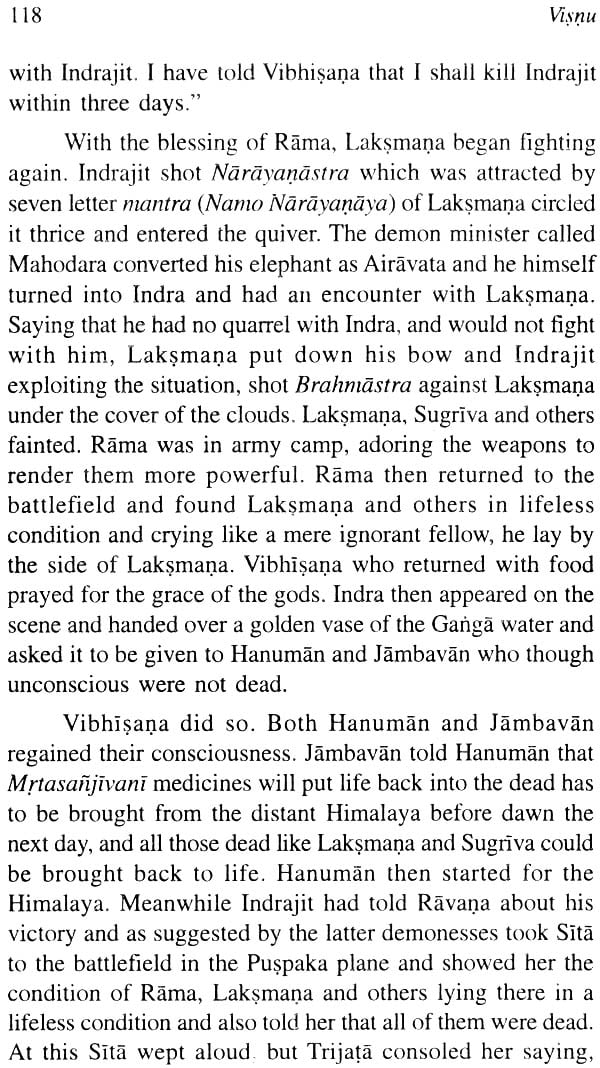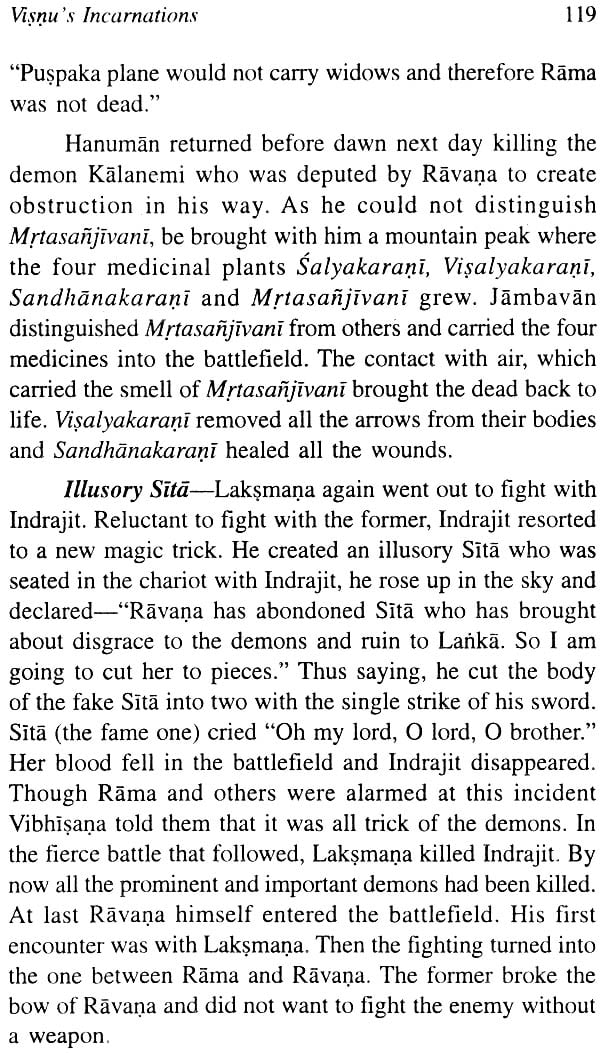
Visnu (The Preserver)
Book Specification
| Item Code: | NAL285 |
| Author: | Shantilal Nagar |
| Publisher: | B.R. Publishing Corporation |
| Language: | English |
| Edition: | 2006 |
| ISBN: | 9788176464819 |
| Pages: | 145 |
| Cover: | Hardcover |
| Other Details | 9.0 inch X 6.0 inch |
| Weight | 310 gm |
Book Description
Visnu is one of the three important gods of Indian religious belief, others being Brahma and Siva. His presence is found in the Rgveda where he is conceived to be all pervading lord. But with the theory of his incarnations, his importance increased. The Puranas, more particularly the visnu and others, highlight his glory to a considerable extent. Some of the events like Samundramanthana (Churning of ocean), event of Gajendramoksa etc. are quite popular. One can find his temples throughout the country.
Shantilal Nagar, a graduate of the Punjab University, served in curatorial capacity in the Central Asian Antiquities Museum, New' Delhi, the Archaeological Museum, Nalanda, and Archaeological Section of the Indian Museum, Calcutta for a number of years. He has to his credit the scientific documentation of over fifty thousand antiquities, in these museums, representing the rich cultural heritage of the country and comprising of sculptures, bronzes, terracottas, beads, seals and sealing, ancient Indian numismatics, wood work, miniatures and paintings, textiles and Pearce collection of gems, ranging from the earliest times to the late medieval period. He was awarded, in 1987, a fellowship, for his monograph on the temples of Himachal Pradesh, by the Indian Council of Historical Research, New Delhi. He has authored more than fifty books.
In India, which is the land of religion, Vaisnavism has its own distinct importance. The genesis of the faith can be traced to the Vedic literature where lord Visnu appears as an important Vedic god. Though at that early stage he is not endowed with four hands and the attributes like sankha, cakra, gada and padma associated with him, but nevertheless he is conceived in the Rgveda as the all pervading god and the Satapatha Brahmana describes the episode of his measuring the earth with three steps. In due course of time he emerged over the Indian religions scene as a powerful god who could control the three worlds with this concept. The Vaisnavism developed as a powerful religions force in the country which had to face several upheavels and challanges from several quarters. The earliest epigraphical records porting him in the form of Gadadhara and in support of this contention an inscribed image of Visnu holding is gada in two of his four hands comes to our rescue which justifies the title of his being a Gadadhara. The conch or sankha was procured by him after killing of a demon named Sankha in the mid-ocean who possessed the conch Paficajanya, which was possibly handed over by him in his incarnation as Krsna to Arjuna, for use in the Mahabharata war.
The Cakra possessed by him was initially with Siva which was required by Visnu for the killing of a demon. To achieve the same, Visnu had to adore Siva offering a thousand lotuses every day. On the lost date of his adoration, however, a lotus was found short and Visnu was unable to procure a replacement suddenly he realised that he enjoyed the epithet of a lotus eyed lord and immediately thereafter he took out a dagger and tried to take out one of his eyes. But Siva atonce appeared on the scene and dissuaded Visnu from doing so, bestowing the cakra to him at the same time. In this way the presence of the attributes of gada, sankha and cakra with Visnu have been accounted for, but in so far as the lotus is concerned it could be due to the fact that the same was emerged from his navel with Brahma seated over the same. There after, the lotus was also shown as one of his four attributes.
In due course of time Laksmi was attached to him as his spouse by the gods. It may be recalled here that once the gods and the demons decided for the churning of the ocean in which the mountain Mandaracala was used as the churning rod and the serpent Vasuki was used as the churning rope. But the process of churning of the ocean could not progress because of the lack of the base, Visnu then took to the form of a tortoise and held the Mandaracala over his back, after which the churning of the ocean was started, as a result of which fourteen gems emerged out of the ocean, the foremost of which was Laksmi, who accepted by Visnu as her consort. With the passage of time his iconography was developed and he was conceived with having four hands holding the usual attributes as detailed above, but he was also made to appear wearing a pitambara (the yellow lower garment) and a kirita crown over the head. He was also stated to be residing in the ocean reclining over the serpent bed. But the time during which the serpent Sesa was made to serve his bed would be difficult to point out. He indeed played a predominent role in the Hindu religious thought and in fact once with the appearance of Visnu over the Indian religions horison, his popularity went on increasing.
The earliest feat of Visnu has been his taking three strides and which have been interpreted by the scholars as the course of the solar deity through the three divisions of the Universe, the god being manifest in a three fold form as Agni on earth, Indra or Vayu in atmosphere, and Surya in the sky. Another school of thought interprets the three strides as relating to the apparent progress of the sun through the firmament. These three steps, in due course of time were developed into a myth relating to the dwarf incarnation of the Puranic Visnu, who happened to be the fifth of the Dasavatara. Indeed the idea of motion, swift and far extending regular motion, is constantly associated with Visnu in the Vedas but the special character of the Puranic Visnu as the preserver and benevolent deliverer is also outlined there. His gradual rise to importance in the later Vedic period, however, was primarily due to his having been identified with sacrifice. There is an episode in the Satapatha Brahmana (14.1.1) according to which Visnu was identified with sacrifice, for he became the most eminent among the gods by first comprehanding its nature. Still there is no doubt about the fact that even in the period of Brahmanas he did not appear as a central figure in a cult pre-eminently thiestic in character, which would require making of his images.
In the epic and Puranic age, Visnu is regarded as the most powerful and influential member of the later Brahmanical triad-Brahma-the creator, Visnu the preserver and Siva the destroyer. But Visnu around whom one of the major Brahmanical cluts grew up was really a result of the Syncretism of three gods concepts, the man god Vasudeva Krsna, the Vedic Sun-god Visnu and the cosmic- god Narayana of the Brahmanas. Vasudeva Krsna---the Satvata hero was really at the root of the Bhakti-cult that came to be known as Vaisnava. It earlier names were Ekantika,Bhagavata, Pancaratra, Satvata etc.
Besides the creativity and the preservation of the Universe, Visnu is also said to fall asleep at the end of every yuga or the age of the world. According to the account given in the Mahabharata, Visnu has been designated as the Pradhanapurusa or the supreme soul, who at the termination of such a long period not only burns the Universe, but as the earth is flooded with water also sleeps on the bed of the serpent Sesa. When finally his creative function is stirred, he awakes. Then being engaged in meditation a lotus springs from his navel and four-faced Brahma emerges seated over the same. The supreme being is then said to continue creating in the form of Brahms. This conception seems to have arisen from the ancient belief of the one or Primordial Being resting on or emanating from the primeval water. Forming part of the later elaborate and periodic system of chronology the destruction and recreation of the world caused by Brahma--- is but a phase of the eternal life. However, reference to Visnu reclining on the oceanic bed frequently occurs in the Puranas and the classical literature. There are a few references in the texts which exhibit the conflict between Visnu and Brahma who was born out of his navel.
| 1. | Introduction | 1-15 |
| 2. | Performance | |
| 3. | Profile in Indian Art | 40-51 |
| 4. | Visnu's Incarnations | 52-145 |
| 5. | Arati of Visnu | 146 |

